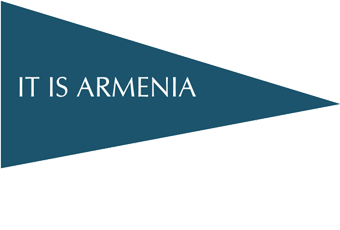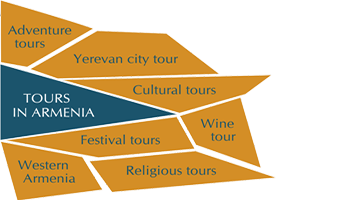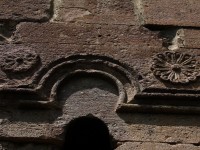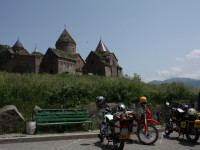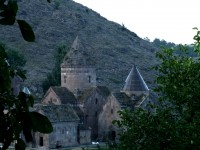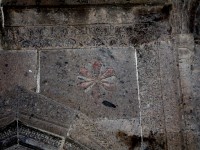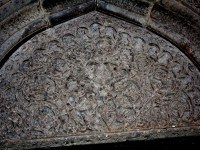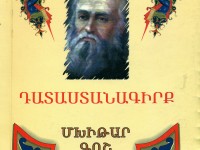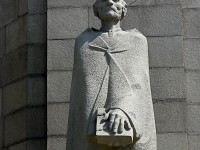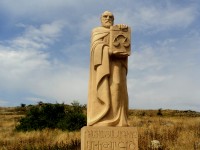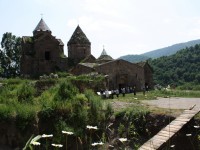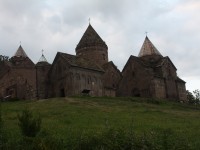Goshavank
The Goshavank or the monastic complex of Nor Guetik was built in 1188 by Ivane Zakharyan. It is located in the village of Gosh of the Tavush Marz (region), on the bank of the river Guetik, 150 km far from the city of Yerevan and 15 km from the city of Dilijan. The monastery is 1200 m above the sea level. The construction of the monastic complex is connected with the name of Mkhitar Gosh (1120-1213), the famous Armenian jurist, scientist, theologian, fabulist of the Middle Ages. And that explains the name “Goshavanq”. But previously, near the monastery was situated the monastery Guetka, which derives its name from the river of Guetik, the stream of Aghstev. This monastery was destroyed by the earthquake and was not restored any more. And because of it Goshavank is often called Nor guetik. As it is evidenced by the historian Kirakos Gandzakeci, the main church of the complex, the church of St. Astvatzatzin (Holly Mother ) was built by the inherent participation of Mkhitar Gosh. The church of St. Astvatzatzin (the Holy Mother) is a domed structure, has two double-decker altars on the eastern side and the entrances on the western and the northern sides. The eastern and the southern walls are handled with the «Armenian Slots» (sections of triangular shape), the thick-edged drum is lined with ornaments. The architect of the gavit (narthex), which was built later, was Mkhitar Hyusn. The gavit (narthex) (1197-1203) with its four columns belongs to the basic type of central gavits (narthexes). In the eastern two corners it has the double-decker altars. The gavit (narthex) of Goshavank by its shape and structural elements, after the Sanahin's, marked the next step in the development of its kind, preparing the same type structures of Haghartsin and Kecharis. Just a little to the south of the church of St. Astvatzatzin (the Holy Mother) is located the Church of St. Gregory, which was built in 1231, and near to the southern wall of the gavit (narthex) stands a small church of the Saint Gregory the Illuminator (Grigor Lusavorich) which was built in 1241. To the north of the gavit (narthex) is the two-story bell tower - library, which was also built in 1241, by the abbot Martiros. The second floor of the library- the bell tower was built by the architects Grigor and Zakhare in 1291. In the territory of the monastery mostly are flaring the embroidered Khachkars (cross-stone).They are the works of art of the end of 13th century and the sculpture master's name is Poghos. The monastery was sponsored by the countess Arzukhatun, the wife of the count of Haterk (13th century). She made large charitable endowments to the complex. As Kirakos Gandzaketsi passed on, she and her daughters knitted and presented the curtains of goat fluff with images of Jesus and the saints on it. The countess Arzukhatun also bounded the curtains of the same kind and presented them to the monasteries Haghpatavank, Dadivank and Makaravank. In the time of Mkhitar Gosh a University used to function here, where foreign languages, philosophy, grammar, music, rhetoric, drawing were taught. The monastery was also the center of a rewriting of ancient manuscripts. Famous medieval figures, historians Kirakos Gandzaketsi and Vardapet (teacher) Vanakan (Hovhannes Tavushetsi) studied and worked here. On the opposite side of the monastery is a small domed church of St. Gevorg, whit three altars. The church was built by Vardapet (teacher) Khachatur and his brother Barsegh in 1254.
Mkhitar Gosh
Mkhitar Gosh is medieval Armenian scholar, legislator, educator, social activist, and fabulist. He was the Vardapet (teacher) of Armenian Church. Was an adviser to the Armenian King Zakhare Zakharyan. He studied at the famous Armenian scientist Hovhannes Tavushetsi, after he went to Cilicia, where hiding his own degree of Vardapet (teacher) studied in the high school of the Black Mount (Arm. Sev ler) and again got the degree of Vardapet. Then he returned to his homeland after many misconceptions stopped in Nor Guetik. Under the patronage of Zakhare and Ivan Zakharyans he built a monastery complex Nor Guetik and opened a high school. He is the author to numerous works, but his fables and "Code of Law" (Datastanaguirk), are of particular importance and value, it is here that the applicable laws of Armenia were firs collected. His "Code of Law"(Datastanaguirk) further was used by many neighboring countries.






